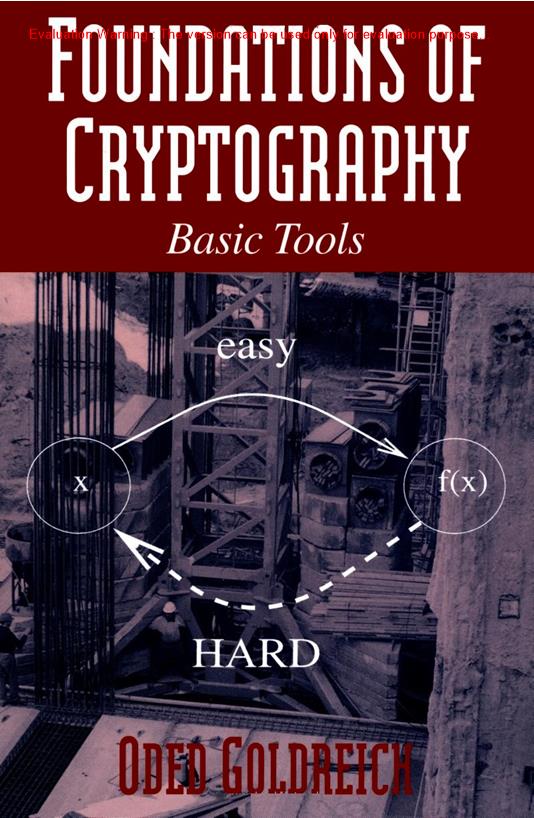《Foundations of Cryptography Volume 1 Basic Tools_Oded Goldreich》pdf电子书免费下载
下载方式一:
百度网盘下载地址:https://pan.baidu.com/s/1YZRKFV5T9cWor6zKfLiJtg
百度网盘密码:1111
下载方式二:
http://ziliaoshare.cn/Download/af_123818_pd_FoundationsofCryptographyVolume1BasicTools_OdedGoldreich.zip
|
|
作者:empty 页数:393 出版社:empty |
《Foundations of Cryptography Volume 1 Basic Tools_Oded Goldreich》介绍
Cryptography is concerned wth the conceptualization, de inition, and construction ofcomputing systems that address security con cems.The design of ery p to graphic systemsmust be based on firm foundations.This book presents a rigorous and systematictreatment of the foundational issues:defining cryptographic tasks and solving newcryptographic problems using existing tools.It focuses on the basic mathematical tools:computational difficulty fone-way functions) , pseudo randomness, and zero-knowledgeproofs.The emphasis is on the clarification of fundamental concepts and on demonstrat-ing the feasibility of solving cryptographic problems rather than on describing adhocapproaches.
The book is suitable for use in a graduate course on cryptography and as a referencebook for experts.The author assumes basic familiarity with the design and analysis ofalgor thms; some knowledge of complexity theory and probability is also usefulOded Goldreich is Professor of Computer Science at the Weizmann Institute of Scienceand incumbent of the Meyer W.We is gal Professorial Chait.An active researcher, hehas written numerous papers on cry pl ography and is widely considered to be one ofthe world experts in the area.He is an edi or of Journal of Cryptology and SIAMJournal on Computi g and the author of Modern Cryptography, Probabilistic Proofsand Pseudo randomness, published in1999by Springer-Verlag.
《Foundations of Cryptography Volume 1 Basic Tools_Oded Goldreich》目录
1.1.Cryptography:Main Topics
1.1.1.Encryption Schemes
1.1.2.Pseudorandom Generators
1.1.3.Digital Signatures
1.1.4.Fault-Tolerant Protocols and Zero-Knowledge Proofs
1.2.1.Notational Conventions
1.2.2.Three Inequalities
1.3.1.P, NP, and NP-Completeness
1.3.2.Probabilistic Polynomial Time
1.3.3.NonUniform Polynomial Time
1.3.4.Intractability Assump tians
1.3.5.Oracle Machines
1.4.1.The Need for a Rigorous Treatment
1.4.2.Practical Consequences of the Rigorous Treatment
1.4.3.The Tendency to Be Conservative
1.5.1.Historie al Notes
1.5.2..Suggestions for Further Reading
1.5.3.Open Problems
1.5.4.Exerci scs
1.2.Some Background from Probability Theory
1.3.The Computational Model
1.4.Motivation to the Rigorous Treatment
1.5.Miscellaneous
vii
One-WayFunetions:Motivation
One-WayFunctions:Definitions
2.2.1.Strang One-Way Fun e tions
2.2.2.Weak One-Way Functions
2.2.3.Two Useful Length Conventions
2.2.4.Candidates for One-Way Functions
2.2.5.Non-Uniformly One-Way Functions
Weak One-Way Function sImply Strong Ones
2.3.1.The Construction and Its Analysis(Proof of Theorem 2.3.2)
2.3.2.Illustration by a Toy Example
2.3.3.Discussion
One-WayFunctions:Variations
2.4.1.Universal One-Way Function
2.4.2.One-Way Functions as Collections
2.4.3.Examples of One-Way Collections
2.4.4.Trapdoor One-Way Permutations
2.4.5. Claw-Free Functions
2.4.6.*On Proposing Candidates
Hard-Core Predicates
2.5.1.Det inition
2.5.2.HardCore Predicates for AnyOne-Way Function
2.5.3. Hard-Core Functions
2.6.1.The Construction
2.6.2.Analysis
2.7.1.Historical Notes
2.7.2.Suggestions for Further Reading
2.7.3.Open Problems
2.7.4.Ex crc is es
3.1.1.Computational Approaches to Rand am ness
3.1.2.A Rigorous Approach to Pseudorandom Generators
3.2.1.Definition
3.2.2.Relation to Statistical Closeness
3.2.3.Indistinguishability by Repeated Experiments
3.2.4.*In distinguish ablity by Circuits
3.2.5.Pseudorandom Ensembles
3.3.1.Standard Definition of Pseudorandom Generators
3.3.2.in crean g the Exp anson Factor
3.3.3.”Variable-Output Pseudorandom Gen cra tors
3.3.4.The Applicability of Pseudorandom Generators
3.3.5.Pseudo randomness and Unpredictability
3.3.6, Pseudorandom Generator sImply One-Way Functions
Constructions Based on One-Way Permutations
3.4, 1.Construction Basc dona Single Permutation
3.4.2.Construction Based on Collections of Permutations
3.4.3.”Using Hard-Core Functions Rather than Predica les
Constructions Based on One Way Functions
3.5.1.Using l-1OneWay Functions
3.5.2.Using Regular One-Way Functions
3.5.3.Gui ng Be y and Regular One-Way Functions
Pseudorandom Functions
3.6.1.Definitions
3.6.2.Construction
3.6.3.Applications:A General Methodology
3.6.4.*Generalizations
3.7.1.Definitions
3.7.2.Construction
Mis cell an co us
3.8.1.Historical Notes
3.8.2.Suggestions for Further Reading
3.8.3.Open Problems
3.8.4, Exercises
Zero-KnowledgeProofs:Motivation
4.1.1.The Notion of a Proof
4.1.2.Gaining Knowledge
4.2.1.Det inition
4.2.2.An Example(Graph Nan-Is on or phism in IP)
4.2.3.*The S true ture of the Class TP
4.2.4.Aug m neat ation of the Model
Zero-KnowledgeProofs:Definitions
4.3.1.Perfect and Computational Zero-Knowledge
4.3.2.An Example(Graph Isomorphism in PZ K)
4.3.3.Zero-Knowledge with Respect to Auxiliary Inputs
4.3.4.Sequential Composition of Zero-Knowledge Proofs
Zero-Knowledge Proofs for NP
4.4.1.Commitment Schemes
4.4.2.Zero-Knowledge Proof of Graph Colo ing
2.6.*Eff cient Amplification of One-Way Functions
2.7.Mis cell an co us
3 Pseudorandom Generators
3.1.Motivating Discussion
3.2.Computational Indistinguishability
3.3.Deti nitions of Pseudorandom Generators
3.7. Pseudorandom Permutations
4Zero-Knowledge Proof Systems
4.2.Interactive Proof Systems
The General Result and Some Applications
Second-Level Considerations
On the Importance of Interaction and Randomness
Limitations of Unconditional Results
Limitations of Statistical ZK Proofs
Z cro-Knowledge and Parallel Composition
Definitions
Par alle 1 Composition
Constructions
Applications
Del inition
Reducing the Knowledge Error
Zero-Knowledge Proofs of Knowledge for NP
Applications
Proofs of Identity(Identification Schemes)
Strong Proofs of Knowledge
De inition
Per feet ly Hiding Commitment Schemes
Per feet Zero-Knowledge Arguments for NP
Arguments of Poly-Logarithmic E ficiency
Using Commitment Schemes with Perfect See rcc y
Bounding the Power of Cheating Prove ts
4.5.”Negative Results
4.6.*Witness Indistinguishability and Hiding
4.7.*Proofs of Knowledge
4.8.*Computationally Sound Proofs(Arguments)
4.9.*Const n-Round Zero-Knowledge Proofs
4.10.*Non-Interact ve Zero-Knowledge Proofs
4.11.*Mult-Prover Zero-Knowledge Proofs
4.12.Miscellaneous
4.10.1.Basic Definitions
4.10.2.Constructions
4.10.3.Extensions
4.11.1.Definitions
4.11.2.Two-Sender Commitment Schemes
4.11.3.Perfect Zero-Knowledge for NP
4.11.4.Applications
4.12.1.Historical Notes
4.12.2.Suggestions for Further Reading
4.12.3.Open Problems
4.12.4.Exercises
A.1.1.Quadratic Residues Modulo a Prime
A.1
